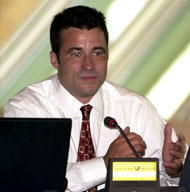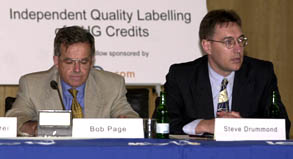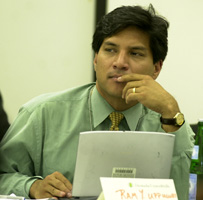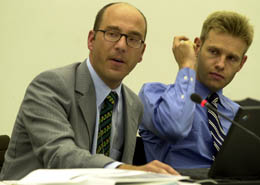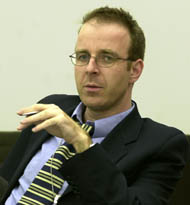|
|
|||||||||||||||||||||||||||||||||||
|
|||||||||||||||||||||||||||||||||||
|
Events convened on Thursday, 19 July 2001 |
|
Independent
quality labeling of GHG credits: Towards transparency and environmental
credibility Presented by the World Wildlife Fund (WWF) and the International Emissions Trading Association (IETA)
Mark Kenber, WWF, described carbon labeling as a tool for promoting renewable energies and energy efficiency. Given the uncertainties associated with the fact that the Clean Development Mechanism (CDM) will commence before rules are in place, he highlighted labeling as a tool to reduce the costs related to these uncertainties. He outlined criteria that should be taken into account in labeling schemes: prioritization of renewable energy and energy efficient technologies; additionality; independently determined and dynamic baselines based on "best in class" comparisons; independent environmental impact assessment; public consultation and participation in project design and implementation; and mechanisms to determine contributions to sustainability. Steve Drummond, CO2e.com, addressed the need for quality labeling of project-based emissions reductions. He emphasized that emissions trading enables the efficient sourcing of lowest cost emissions reductions, and reduces the economic impact of reduction activity. He said trading mechanisms focus corporate capital and creativity on emissions reduction activities. Drummond described the financial hedging market, where companies buy emissions reductions to hedge exposure under anticipated national regulatory schemes. He underscored that credible labeling schemes enable a trusted third party to assess the environmental integrity of emissions reductions, and increase the certainty of environmental benefits and the investment value for buyers.
Bob Page, TransAlta, compared the establishment of greenhouse gas (GHG) credits to the creation of a new currency, and stressed the need for integrity and the definition of a "gold standard" for this currency. He said the value of the CDM and joint implementation will be judged based on the credibility of credits and their transaction costs. He stressed the importance of private sector initiatives to reduce emissions, and emphasized that third party labeling provides assurance to the private sector, and is more robust and credible with NGO involvement. Chandra Sinha, World Bank, described the Bank's Prototype Carbon Fund (PCF), a closed-end mutual fund structure with a diverse portfolio that provides competitively priced, high quality emissions reductions and seeks to minimize project risks and reduce transaction costs. PCF project selection criteria include: UNFCCC criteria for the CDM; World Bank standards; a 3:2 ratio of renewables and energy efficiency; proven and low risk technology; environmental additionality; and balance between the CDM and joint implementation, with initial emphasis on the CDM. More
information: Contact: |
|
Cars and Climate: A Trans-atlantic coalition Presented by the German NGO Forum on Environment and Development and Deutsche Umwelthilfe At this event, speakers presented near-term measures to reduce CO2 emissions from traffic and experiences from their implementation.
Jürgen Resch, Deutsche Umwelthilfe, introduced this event, underscoring that traffic is a major and growing source of CO2 emissions. He described the coalition as an action network of German and US NGOs, government agencies and industry, which was formed to identify and implement concrete measures for the immediate reduction of CO2 emissions from traffic. Hans Jürgen Schäfer, Volkswagen AG, described near-term developments in engine technologies and improvements in fossil fuels that will reduce CO2 emissions from vehicles. Ram Y. Uppuluri, Environmental Defense, highlighted three obstacles to improving transportation problems in the US: the Bush Administration's rejection of the Kyoto Protocol and the resultant decline in corporate interest in transportation improvement programmes; low gasoline taxes and prices; and low fuel economy standards for passenger vehicles. He noted that there has been a recent resurgence in interest in the US to improve fuel efficiency. Axel Friedrich, Umweltbundesamt, highlighted the ability of low roll-resistance tires to reduce fuel consumption and CO2 emissions by five percent, at very low cost and without compromising safety or increasing noise. Martin Völtz, British Petroleum (BP), described how the use of super-efficient lubricants reduces friction, thereby reducing fuel consumption and exhaust emissions from vehicles. Kay Schulte, German Road Safety Council, described a training programme to educate employees about safe, economical and environmentally friendly driving. Peer Seipold, OTTO Versand, outlined how his company, a growing mail order business, realized a 46 percent reduction in CO2 emissions since 1993, by using alternative fuel vehicles, implementing technical optimization measures, and raising employee awareness. Discussion: Participants highlighted tax incentives for sulfur-free fuel in Germany, liquid hydrogen fuels, and the perception of a trade-off between safety and higher fuel economy. More
information: Contact: |
|
Integration of emissions trading schemes Presented by the International Emissions Trading Association (IETA) Peter
Vis, European Commission, outlined ten key points to consider
when integrating emissions trading systems. He noted that integration
can be problematic as it may lower standards, particularly with
respect to compliance mechanisms, criteria for project offset
categories, banking and borrowing. Vis also cited difficulties
in measuring and attributing emissions, particularly for cross-border
electricity trading.
Chris Boyd,
Lafarge, noted that most industries support emissions trading
in recognition that the world is becoming increasingly carbon-constrained.
He stated that wide integration of national trading systems
is desirable because it increases efficiency. Boyd questioned
the viability of an entirely voluntary trading system, and suggested
that governments should assist with monitoring, reporting, developing
criteria, and ensuring compliance. Henry Derwent,
UK Department of Environment, Food and Rural Affairs, spoke
about the UK's emissions trading scheme, which consists of three
mutually exclusive components. The first component is a climate
change levy, the second requires that companies bid for financial
incentives, and the third involves emissions reductions projects
based on the model of joint implementation. Although the schemes
are voluntary, incentives for participation are provided. Garth Edward,
Natsource, explained that the integration of emissions trading
schemes is beneficial as it improves liquidity and lowers the
cost of pollution abatement. He emphasized that integration
also creates technical issues of jurisdictional arbitrage, where
the weakest regulation in one country will effectively apply
across all trading partners. He stressed that integration will
require a common unit of exchange as well as national registries.
More
information: Contact: |
|
Implementing the Kyoto mechanisms: Contributions by financial institutions Presented by the University of St. Gallen Institute for Economic and Environment
Josef Janssen,
University of St. Gallen, introduced the objectives of the European
research and development project to develop financial products
to meet the needs of participants in GHG emissions markets.
The project, Janssen explained, aims to explore how private-sector
financial institutions may contribute to effective and efficient
implementation of GHG emissions trading systems and the Kyoto
mechanisms. He explained that projects are structured around
nine work themes and provide interaction between researchers,
insurance companies, brokers and financial bankers. He described
risk diversification in GHG reduction portfolios, highlighting
to carbon investors that the key to risk diversification lies
in the potential to diversify across different industries, rather
than across different technologies. Garth Edward,
Natsource-Tullett Europe, presented the GHG price scenario impact
of different Kyoto policy regimes. He spoke about "realities"
of the market and outlined his experience in market pricing
variation in terms of policy, bench-testing against the SO2
and NOx market, development of GHG clearing price predictions
under different policy scenarios, and comparing pricing models
against developing the forward curve of CO2.
He shared lessons from the SO2 market
experience and concluded that emissions trading of CO2
differs in providing low cost options for emissions reductions
targets. Dirk Kohler,
Gerling Sustainable Development Project, outlined three key
insurance objectives: to consider client-based concerns regarding
credits; to reassess developing country ratings and risk assessment;
and to value liability between sellers and buyers. He called
for a clear framework and clarification of the risks of the
Kyoto mechanisms. Regina Betz, Fraunhofer Institute, presented a manual entitled "Implementing Flexible Mechanisms: A Manual for Companies," which enables and motivates companies to reflect on flexible mechanisms for their business and facilitates participation of companies through easily accessible information. Frank Gagelmann, Fraunhofer Institute, described the manual's structure of checklists and decision trees of project phases, cycles and institutions, and illustrated a database programme on emissions calculations, including efficiency gains. More
information: Contact: |
|
Helping developing countries to leapfrog toward clean technologies Presented by Global Legislators for a Balanced Environment (GLOBE) This event adresssed the issue of North-South technology cooperation for improving developing country energy services in an environmentally benign manner.
Charles Nicholson, BP, emphasized that energy fuels all activities in OECD countries, yet billions of people in the developing world remain without access to commercial energy. He noted that there is no shortage of fossil fuel supplies, especially now that reserves in Latin America, Africa and the former USSR have become available to foreign investment. Nicholson highlighted that BP is one of the largest solar companies in the world, and that solar power generation is ideal for many developing country communities without access to the power grid. He stressed that transfer of technology to developing countries requires more than handing over equipment, but also building capacity and skill. Liam Salter, WWF, outlined the report of the G-8 Renewable Energy Task Force, which discusses ways in which Northern governments can encourage the use of renewables in developing countries with the aim of providing one billion people with renewable energy. The report indicates that barriers to renewables include high capital costs, insufficient human and institutional capacity, and inconsistent policies. The report recommends that governments support the renewable energy industry by removing subsidies to environmentally harmful energy systems, setting environmental guidelines and standards for export credit agencies, and developing national plans, targets and quotas. The report also suggests that corporations make an effort to procure renewables and green electricity. Salter stressed the need for G-8 governments to implement the report's recommendations, with or without the support of the US and Canada. Paul Metz, e5 - European Business Council for Sustainable Energy, stated that many developing countries are well-positioned to utilize renewable energy such as solar power due to their geographical location and large populations not connected to the power grid. Metz noted the potential for micro-financing, given the small scale of many renewable energy projects in developing countries, and stated that export credit agencies should focus funding on cleaner energy technologies. More
Information: Contact: |
|
|
|
| The Earth Negotiations Bulletin (ENB) on the side is a special publication of the International Institute for Sustainable Development (IISD) in cooperation with the United Nations Framework Convention on Climate Change (UNFCCC) Secretariat. The Editor of ENB on the side is Kira Schmidt <kira@iisd.org>. This issue has been written by Emily Boyd <emily@iisd.org>, Fiona Koza <fiona@iisd.org> and Kira Schmidt <kira@iisd.org>. The Digital Editors are Andrei Henry <andrei@iisd.org> and Kenneth Tong <ken@iisd.org>. Photos by Leila Mead <leila@iisd.org>. Funding for publication of ENB on the side at COP-6 Part II is provided by the UNFCCC Secretariat. The opinions expressed in ENB on the side are those of the authors and do not necessarily reflect the views of IISD and funders. Excerpts from ENB on the side may be used in non-commercial publications only and only with appropriate academic citation. For permission to use this material in commercial publications, contact the Managing Editor at <kimo@iisd.org>. Electronic versions of these issues of ENB on the side from COP-6 Part II can be found on the Linkages WWW server at http://enb.iisd.org/climate/cop6bis/enbots/. | |
|
|
| © 2001, IISD. All rights reserved. |
|



